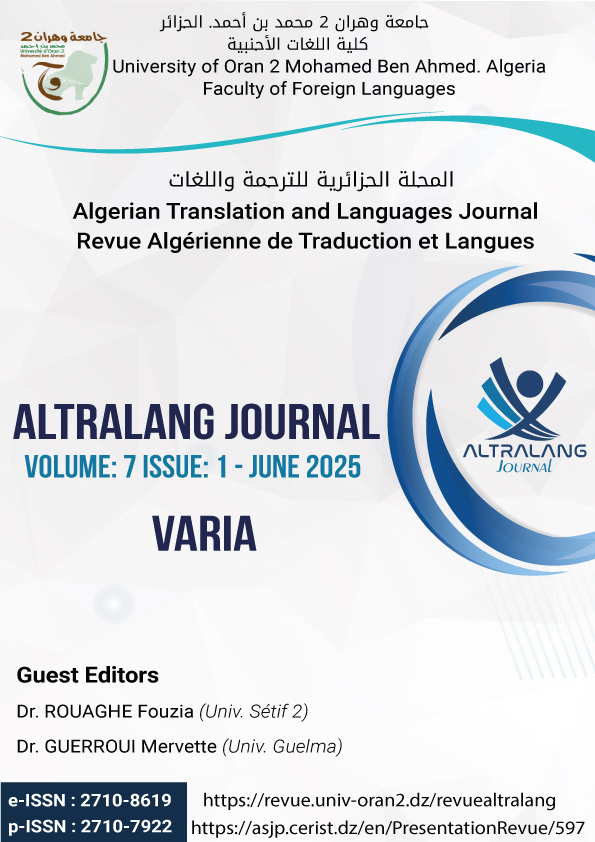Interdisciplinary Collaboration for Synergistic ESP Pedagogy at Chlef University in Algeria
Main Article Content
Abstract
This study examines a crucial component of language education; the collaboration between English for Specific Purposes (ESP) teachers and subject-matter instructors (SMIs). The primary objective is to explore how ESP teachers at Chlef University in Algeria perceive this collaborative effort, seeking insights to enhance language education and subject integration. To gain a deeper understanding of their collaborative dynamics with the SMIs and elicit their opinions, the methodology involved distributing an online questionnaire to thirteen ESP teachers from different faculties at Chlef University. The results underscored the critical necessity of aligning subject-specific content with the pedagogical framework of language instruction, exposing previously unnoticed gaps in cooperative efforts. Despite the limitations, such as the singular institutional focus and small sample size, the suggested improvements for ESP instruction and subject integration encompassed a variety of strategic tactics. These included implementing interdisciplinary workshops, fostering reliable communication, and engaging in joint lesson planning. The findings may contribute to a more harmonious convergence of subject knowledge and language proficiency, addressing challenges and propelling the educational landscape forward.
Article Details

This work is licensed under a Creative Commons Attribution 4.0 International License.
LICENSE: This work is licensed under a Creative Commons CC BY 4.0 license
References
• Basturkmen, H., & Shackleford, N. (2015). How content lecturers help students with language: An observational study of language-related episodes in interaction in first-year accounting classrooms. English for Specific Purposes, 37, 87–97. https://doi.org/10.1016/j.esp.2014.08.001
• Brinton, D. M., Snow, M. A., & Wesche, M. B. (1989). Content-based second language instruction. Newbury House Publishers.
• Corin, A. (1997). A course to convert Czech proficiency to proficiency in Croatian and Serbian. In S. B. Stryker & B. L. Leaver (Eds.), Content-based instruction in foreign language education: Models and methods (pp. 78-104). Washington, DC: Georgetown University Press.
• Davis, J. R. (1995). Interdisciplinary courses and team teaching. Washington, DC: Oryx Press.
• Dudley-Evans, T. (2001). Team-teaching in EAP: Changes and adaptations in the Birmingham approach. In J. Flowerdew & M. Peacock (Eds.), Research perspectives on English for academic purposes (pp. 225-238). Cambridge: Cambridge University Press.
• Katsura, H., & Matsune, M. (1994). Team teaching in university conversation courses. In M. Wada & A. Cominos (Eds.), Studies in team teaching (pp. 178-185). Tokyo: Kenkyusha.
• Lo, Y. Y. (2014). Collaboration between L2 and content subject teachers in CBI: Contrasting beliefs and attitudes. RELC Journal, 45(2), 181–196. https://doi.org/10.1177/0033688214535054
• Rosenkjar, P. (2002). Adjunct courses in the great books: The key that unlocked Locke for Japanese EFL undergraduates and opened the door to academia for EFL. In J. Crandall & D. Kaufman (Eds.), Content-based instruction in higher education settings (pp. 13-28). Alexandria, VA: Teachers of English to Speakers of Other Languages, Inc.
• Shaw, P. A. (1997). With one stone: Models of instruction and their curricular implications in an advanced content-based foreign language program. In S. B. Stryker & B. L. Leaver (Eds.), Content-based instruction in foreign language education: Models and methods (pp. 261-282). Washington, DC: Georgetown University Press.
• Stewart, T., Sagliano, M., & Sagliano, J. (2002). Merging expertise: Developing partnerships between language and content specialists. In J. Crandall & D. Kaufman (Eds.), Content-based instruction in higher education settings (pp. 29-44). Alexandria, VA: Teachers of English to Speakers of Other Languages, Inc.
• Sturman, P. (1992). Team teaching: A case study from Japan. In D. Nunan (Ed.), Collaborative language learning and teaching (pp. 141-161). Cambridge, UK: Cambridge University Press.
• Vargas Vásquez, J. M., Moya Chaves, M., & Garro Morales, C. (2016). The roles of the instructors in an ESP-task-based language teaching course. Actualidades Investigativas en Educación, 16(1). https://doi.org/10.15517/aie.v16i1.21974
• Wada, M., & Cominos, A. (Eds.). (1994). Studies in team teaching. Tokyo: Kenkyusha.

1.png)